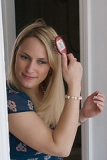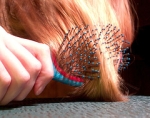Hair Styling Tools And Appliances
Brushes, combs and pins are the basic tools of styling. The following is a guide to help you choose what is most suitable from the wide range that is available.

Brushes:
These are made of bristles (sometimes called quills or pins), which may be natural hog bristles, plastic, nylon or wire. The bristles are embedded in a wooden, plastic or moulded rubber base and set in tufts or rows. This allows loose or shed hair to collect in the grooves without interfering with the action of the bristles. The spacing of the tufts plays an important role – generally, the wider the spacing between the rows of bristles, the easier the brush will flow through the hair.
The role of brushing: Brushes help to smoothen the hair by removing tangles and knots. The way you brush your hair from the roots to the ends removes dead skin cells and dirt, and encourages the cuticles to lie flat. Brushing also stimulates the blood supply to the hair follicles, increasing hair growth.
Types Of Bristles:
1. Natural bristles: These are produced from natural keratin (the same material as hair) creating less friction and not harming the hair. These brushes are good for grooming and polishing the hair, and helps to control flyaway hair. You must use a softer bristle brush for thin hair. Brushes with natural bristles will not penetrate wet or thick hair.
2. Plastic, nylon or wire bristles: These bristles are easily cleaned and heat resistant, and are good for blow-drying. Cushioned brushes give good flexibility and they go through the hair, preventing pulling and removes knots. They are non-static and are available in all varieties and styles. One disadvantage is that the ends can be harsh and can scratch the scalp, so it is better to use bristles which are rounded or ball tips.

Cleaning Brushes: All brushes should be cleaned by removing dead hairs and washing in warm, soapy water, then rinsing thoroughly. Natural bristle brushes should be placed bristle-side down and left to dry naturally. If you use a pneumatic brush with a rubber cushion base, block the air hole with a matchstick before washing.
Types Of Brushes:
1. Circular or radial brushes: These come in a variety of sizes and are circular or semi-circular in shape. These brushes have either mixed bristles for finishing, a rubber pad with nylon bristles, or metal pins for styling. They are used to control curly hair, permed hair and wavy hair and are ideal for blow-drying. The diameter of the brush determines the resulting volume and movement, in much the same way as the size of rollers do.
2. Flat or half-round brushes: They are ideal for wet or dry hairstyling and blow-drying. Normally they are made of nylon bristles in a rubber base. Some bases slide into position on to the plastic moulded handle. Rubber bases can be removed for cleaning and replacement bristles are available at times.
3. Pneumatic brushes: These have a domed rubber base with bristles set in tufts. They come in varieties of plastic, natural bristle, or both.

4. Vent brushes: All these have hollow centres allowing the air-flow from the dryer to pass through the brush. Special bristle, or pin, patterns are designed to lift and disentangle even wet hair. Vents and tunnel brush heads enable the air to circulate freely through both the brush and the hair so the hair dries faster.
Brush Tips: Replace brushes and combs with damaged bristles or broken teeth, the sharp edges can damage your scalp. Keep your brushes and combs to yourself, never lend them to other people.